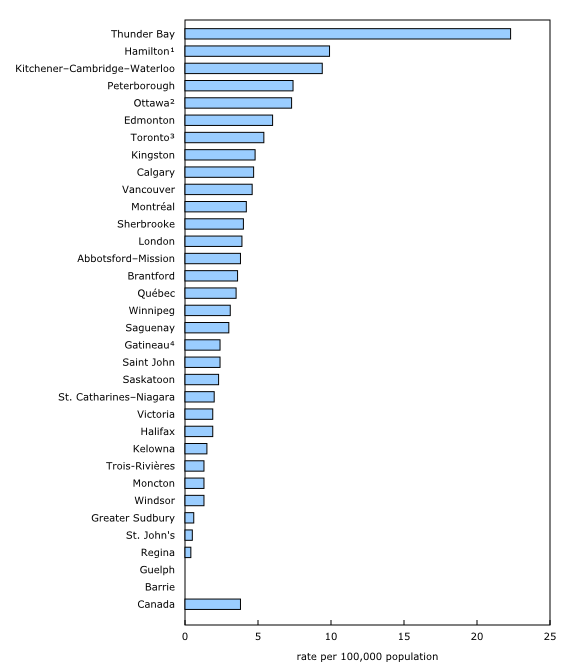Chart 1
Police-reported hate crimes, by census metropolitan area, 2015

1.
Excludes the portion of Halton Regional Police Service that polices the Hamilton CMA.
2.
Ottawa refers to the Ontario part of the Ottawa–Gatineau CMA.
3.
Excludes the portions of Halton Regional Police Service and Durham Regional Police Service that police the Toronto CMA.
4.
Gatineau refers to the Quebec part of the Ottawa–Gatineau CMA.
Note(s):
A census metropolitan area (CMA) consists of one or more neighbouring municipalities situated around a major urban core. A CMA must have a total population of at least 100,000 of which 50,000 or more live in the urban core. To be included in the CMA, other adjacent municipalities must have a high degree of integration with the central urban core, as measured by commuting flows derived from census data. A CMA typically comprises more than one police service. CMA populations have been adjusted to follow policing boundaries. The Oshawa CMA is excluded from this chart due to the incongruity between the police service jurisdictional boundaries and the CMA boundaries. In 2015, coverage for each CMA was virtually 100%, with the exception of Saskatoon (99%), Brantford (95%), Windsor (91%), Toronto (91%), and Hamilton (74%).
Source(s):
Statistics Canada, Canadian Centre for Justice Statistics, Incident-based Uniform Crime Reporting Survey.
Chart description
This is a bar clustered chart.
| rate per 100,000 population | |
|---|---|
| Thunder Bay | 22.3 |
| Hamilton¹ | 9.9 |
| Kitchener–Cambridge–Waterloo | 9.4 |
| Peterborough | 7.4 |
| Ottawa² | 7.3 |
| Edmonton | 6.0 |
| Toronto³ | 5.4 |
| Kingston | 4.8 |
| Calgary | 4.7 |
| Vancouver | 4.6 |
| Montréal | 4.2 |
| Sherbrooke | 4.0 |
| London | 3.9 |
| Abbotsford–Mission | 3.8 |
| Brantford | 3.6 |
| Québec | 3.5 |
| Winnipeg | 3.1 |
| Saguenay | 3.0 |
| Gatineau⁴ | 2.4 |
| Saint John | 2.4 |
| Saskatoon | 2.3 |
| St. Catharines–Niagara | 2.0 |
| Victoria | 1.9 |
| Halifax | 1.9 |
| Kelowna | 1.5 |
| Trois-Rivières | 1.3 |
| Moncton | 1.3 |
| Windsor | 1.3 |
| Greater Sudbury | 0.6 |
| St. John's | 0.5 |
| Regina | 0.4 |
| Guelph | 0.0 |
| Barrie | 0.0 |
| Canada | 3.8 |
1.
Excludes the portion of Halton Regional Police Service that polices the Hamilton CMA.
2.
Ottawa refers to the Ontario part of the Ottawa–Gatineau CMA.
3.
Excludes the portions of Halton Regional Police Service and Durham Regional Police Service that police the Toronto CMA.
4.
Gatineau refers to the Quebec part of the Ottawa–Gatineau CMA.
Note(s):
A census metropolitan area (CMA) consists of one or more neighbouring municipalities situated around a major urban core. A CMA must have a total population of at least 100,000 of which 50,000 or more live in the urban core. To be included in the CMA, other adjacent municipalities must have a high degree of integration with the central urban core, as measured by commuting flows derived from census data. A CMA typically comprises more than one police service. CMA populations have been adjusted to follow policing boundaries. The Oshawa CMA is excluded from this chart due to the incongruity between the police service jurisdictional boundaries and the CMA boundaries. In 2015, coverage for each CMA was virtually 100%, with the exception of Saskatoon (99%), Brantford (95%), Windsor (91%), Toronto (91%), and Hamilton (74%).
Source(s):
Statistics Canada, Canadian Centre for Justice Statistics, Incident-based Uniform Crime Reporting Survey.
- Date modified: